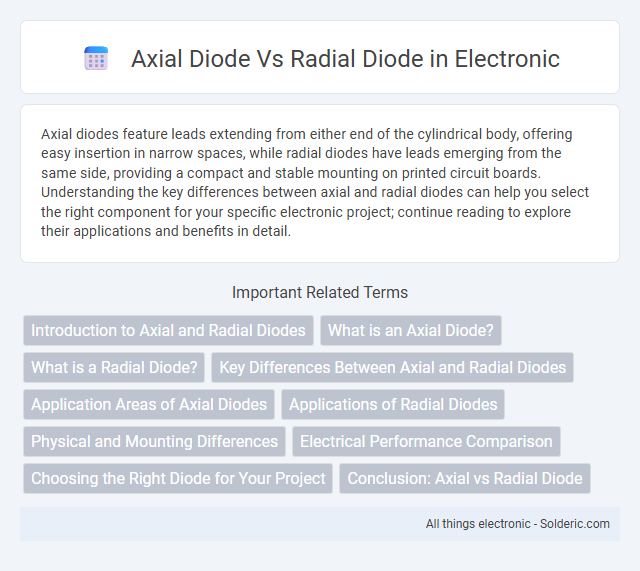Axial diodes feature leads extending from either end of the cylindrical body, offering easy insertion in narrow spaces, while radial diodes have leads emerging from the same side, providing a compact and stable mounting on printed circuit boards. Understanding the key differences between axial and radial diodes can help you select the right component for your specific electronic project; continue reading to explore their applications and benefits in detail.
Comparison Table
| Feature | Axial Diode | Radial Diode |
|---|---|---|
| Construction | Lead wires extend from both ends (axial leads) | Lead wires extend from one end, with radial leads |
| Size and Shape | Cylindrical, longer body | Compact, shorter body |
| Mounting | Through-hole, inline mounting | Through-hole, vertical mounting |
| PCB Space Efficiency | Less efficient, occupies more board space | More efficient, saves board space |
| Common Applications | General-purpose rectification, power supplies | Compact circuits, surface-mount alternatives |
| Heat Dissipation | Typically better due to elongated form | Less optimal; compact size limits heat spread |
| Mechanical Strength | More prone to lead bending/damage | More robust due to compact leads |
Introduction to Axial and Radial Diodes
Axial diodes feature a cylindrical body with leads extending from each end, making them suitable for through-hole PCB mounting and linear circuit layouts. Radial diodes have a compact, disc-shaped body with leads protruding from one side, optimizing space-efficient mounting on printed circuit boards. The choice between axial and radial diodes depends on design constraints such as PCB layout, component density, and mechanical stability requirements.
What is an Axial Diode?
An axial diode features a cylindrical body with leads extending from both ends, allowing current to flow along the axis of the component, and is commonly used in low-frequency, high-current applications due to its simple construction and reliable performance. Its design promotes easy insertion into circuit boards where space is limited in the radial direction but more available along the axial line. Compared to radial diodes, axial diodes typically offer better mechanical strength and heat dissipation characteristics, making them suitable for power rectification and signal limiting processes.
What is a Radial Diode?
A radial diode features leads extending from one end of the cylindrical or tubular package, allowing for compact and efficient PCB mounting in axial directions. It offers lower inductance and improved thermal performance compared to axial diodes, which have leads on opposite ends. Radial diodes are commonly used in power rectification, switching, and protection circuits where space-saving and reliability are critical.
Key Differences Between Axial and Radial Diodes
Axial diodes have leads extending from both ends of the cylindrical body, enabling straightforward series or parallel circuit placement, whereas radial diodes feature two leads protruding from one side, allowing for compact vertical mounting on PCBs. Radial diodes are preferred for high-density circuit boards due to their smaller footprint and ease of automated assembly, while axial diodes offer better mechanical strength and are commonly used in through-hole applications. The choice between axial and radial diodes depends on design requirements such as space constraints, assembly method, and electrical performance needs.
Application Areas of Axial Diodes
Axial diodes are commonly used in high-frequency and switching applications due to their compact design and efficient heat dissipation capabilities. These diodes are ideal for power rectification in electronic circuits, signal processing, and voltage regulation in consumer electronics, automotive systems, and industrial equipment. Your projects benefit from axial diodes when space is limited and reliable performance in fast-switching scenarios is required.
Applications of Radial Diodes
Radial diodes are primarily used in compact electronic devices due to their space-saving cylindrical design, which facilitates easy mounting on printed circuit boards (PCBs). Their efficient heat dissipation and robust construction make them ideal for power rectification in power supplies, battery chargers, and voltage regulation applications. If you need reliable performance in miniaturized circuits, radial diodes offer an excellent solution for managing current flow effectively.
Physical and Mounting Differences
Axial diodes feature a cylindrical body with leads extending from each end, making them ideal for through-hole mounting on circuit boards where space along the board's plane is available. Radial diodes have leads protruding from the same side, allowing for a more compact vertical mounting that conserves board space and improves thermal performance. Your choice between axial and radial diodes depends on the circuit design constraints, such as available space and mounting orientation preferences.
Electrical Performance Comparison
Axial diodes typically exhibit lower forward voltage drop and faster switching speeds due to their streamlined current path, enhancing efficiency in high-frequency applications. Radial diodes generally offer superior thermal dissipation and higher current handling capability, attributed to their larger junction area and robust packaging. Electrical performance differences between axial and radial diodes influence their suitability for power rectification, signal processing, and high-current circuits.
Choosing the Right Diode for Your Project
Axial diodes feature leads extending from opposite ends, making them ideal for through-hole PCB designs with linear layouts, while radial diodes have leads coming out from the same side, saving space and simplifying wave soldering. Choosing the right diode depends on your project's PCB layout, space constraints, and assembly process compatibility. Understanding these form factors ensures optimal fit, thermal performance, and electrical reliability for your circuit design.
Conclusion: Axial vs Radial Diode
Axial diodes feature leads extending from both ends of a cylindrical body, offering easier integration in low-profile and through-hole PCB designs, while radial diodes have leads protruding from one side, enabling compact mounting and denser circuit layouts. Radial diodes typically provide better heat dissipation due to their larger surface area, making them suitable for high-power applications, whereas axial diodes excel in signal and general-purpose uses due to their straightforward orientation. Choosing between axial and radial diodes depends on specific circuit requirements, including space constraints, thermal management, and assembly preferences.
Axial diode vs radial diode Infographic

 solderic.com
solderic.com